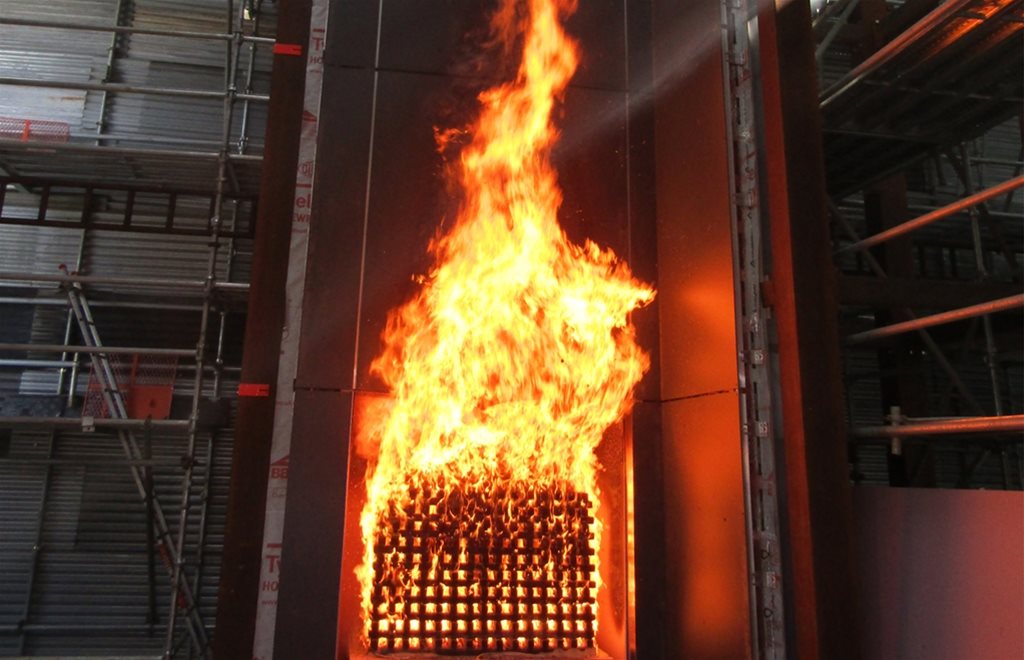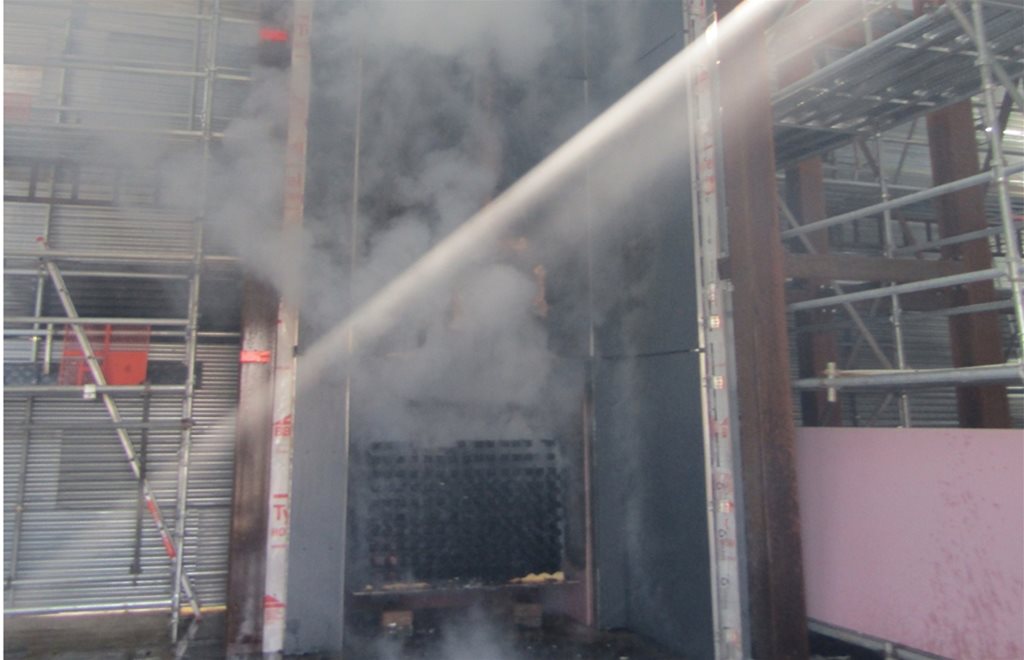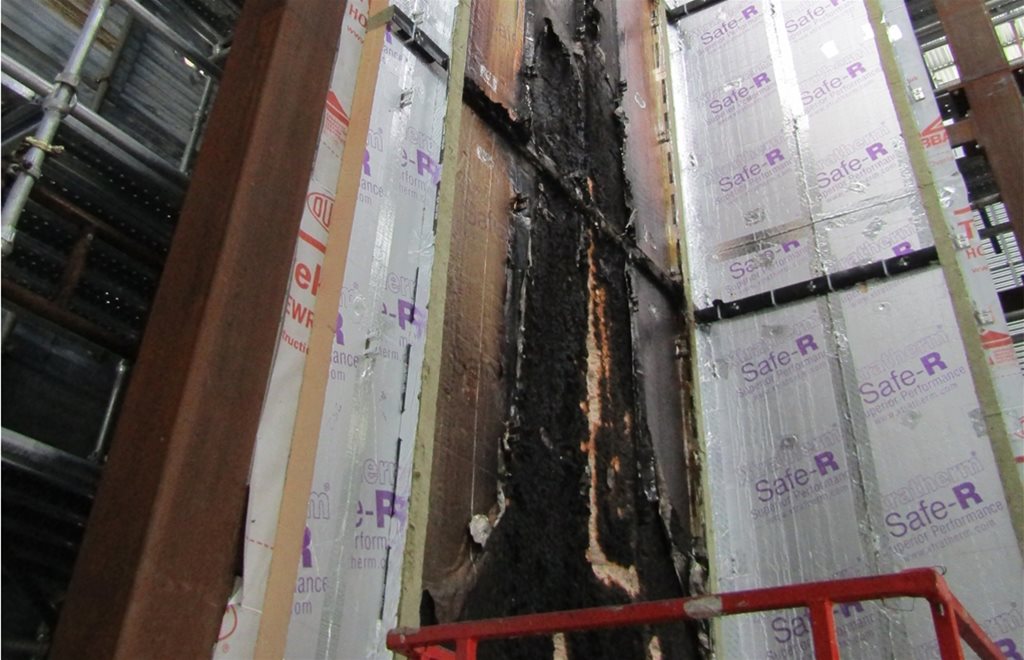Jonathan Evans pulls no punches in his straight talking perspective on where building safety and fire regulations need to go in the public interest
In late 2014, it was evident that the Ministry of Housing, Communities and Local Government (MHCLG) had two pressing issues to contend with. The Secretary of State, Lord Pickles, had received a letter from the Lakanal House inquest coroner urging a review of Approved Document B (ADB) of the Building Regulations, and minutes from a meeting with the Centre for Window and Cladding Technology (CWCT) show that there were concerns about the use of aluminium composite material (ACM) in the aftermath of numerous portentous fi res around the world.
ADB review?
Later that same year, it appears that MHCLG therefore commissioned the Building Research Establishment (BRE) to investigate whether the current guidance relating to external fire spread needed to be reviewed. Almost two years later, the conclusion of that BRE investigation by Crowder, Shipp and Holland was: ‘With the exception of one or two unfortunate but rare cases, there is currently no evidence from these investigations to suggest that the current recommendations, to limit vertical fire spread up the exterior of high-rise buildings, are failing in their purpose.’
Consequently, there were no significant changes to ADB, nor was there any guidance issued in the meantime urging building control to exercise caution on the approval of polyethylene (PE) cored ACM. Perhaps the Grenfell public inquiry will reveal why this failed to happen.
Blinkered ACM focus
Since the tragedy, it’s fair to say that almost every aspect of ADB external wall fire spread guidance has unravelled step by step with each catastrophic fire. After Grenfell, the initial focus of MHCLG and its advice seemed to be to contain the scale of the problem and the associated impact on the Treasury. The blinkered focus was on ACM on buildings over 18m, downplaying the potential for issues extending to other materials and lower, more numerous buildings. When I was invited to suggest what else could be done in the aftermath of Grenfell, I strongly urged that other materials, such as high pressure laminates (HPL), should also be looked at. This was firmly rejected.
After the strength of public opinion became clear on Question Time on the day Judith Hackitt published her report, Dominic Raab announced that a combustible ban would be implemented. Sir Ken Knight, who chairs the Independent Expert Panel, went on to argue – contrary to overwhelming public opinion – that such a ban was unnecessary and should be limited to the exact material that clad Grenfell.

Hackitt's 'system' focus
As a manufacturer of cladding systems, I have seen the huge impact the combustible ban has had on the design of tall buildings, and the attitude and rigour of those involved in it. It’s amazing how competent people can become when it’s in their financial interests. Hackitt’s remit forced her to totally ignore the regulations that impact on the design principles of a building, and that the public was led to believe would be reviewed. Instead, she entirely focused on the regulatory ‘system’. Unsurprisingly, given that she actually based herself in MHCLG’s offices, we ended up with a review that was totally outward looking and failed to examine the role of the regulatory body, how it was guided and what its intentions were. If you’re going to look at the ‘system’, you have to examine who writes the software.
Consultation issues
Hackitt also missed the system problem with consultations (the recent combustible ban review concluded on 25 May). The self declared purpose of MHCLG is ‘to create great places to live and work, and to give more power to local people to shape what happens in their area’. Hackitt failed to identify how the consultation process undermines this.
It’s obvious that the public consists of those most likely to face the consequences of the risks others decide to expose us to, but who are the least likely to voice their opinions in a consultation. Instead, consultations are dominated by corporations, especially those which have the time and resources to protect their commercial interests. If I had written the regulatory review, the first recommendation
would have been to restate the objectives of the regulator, making the public and its safety the priority. Safety is paramount and deregulating it is a false economy.
Regulatory body failings
Those who contribute to this field require a vision to guide us, to which we can resort whenever there is disagreement. Successful endeavours need some kind of vision, mission, objective or strategy. Failing those, the very least you need is a philosophy. This is where leadership comes in, and the lack of it within our regulatory body was something that Hackitt also overlooked.
Leadership is essential in resolving disputes and differences of opinion, often highlighted through consultations. Historically, where there has been polar disagreement, as in the 2017 EU review on toxicity, the conclusion is all too often that ‘agreement couldn’t be reached’ and thus nothing gets done. I was recently involved in the review of BS 8414 for the fire performance of external cladding systems, conducted by the British Standards Institute. There was no brief or guidance; we didn’t know what we were expected to do; and everybody had a different opinion.
I do sense that within MHCLG – given the heightened political importance and media attention the use of combustible materials attracts – this is no longer an acceptable way to function. Another recommendation I would make is that the consultation process and the Building Act’s legal requirement to undertake consultations in the event of a significant change in the regulations are reviewed to limit the potential interference of corporations on the wishes of the general public. This would prevent things happening such as the British Association of Blinds and Shutters overturning part of the combustible ban because the consultation was not conducted fairly.

Contrived remit
With an unashamedly contrived remit, Hackitt deliberately avoided the subject of a combustible ban; however, on the day she published her report, she could not avoid being pressed on it. In doing so, she revealed something quite startling. Having spent almost nine months on the subject, as a graduate engineer and Fellow of the Royal Academy of Engineering, on the day she published her report, she stated: ‘I’m very clear that the regulations and the guidance that exist today already says
that the only type of cladding that you can use on high-rise buildings must either be of limited combustibility or must be subject to a full test.’
Judith Hackitt hasn’t tried to hide her disdain for levels of competence and ethical standards within the construction sector. We’re constantly told to look to other industries (aerospace, automotive etc) to see how they manage to do things so much better. Yet you don’t have to think hard to come up with catastrophes at least equal to Grenfell in all major industries.
We now have legislation passing through parliament based on 53 recommendations originating from her belief that the industry was failing to implement something that was required by the guidance and regulations. In itself, that is a mistake of catastrophic proportions and precisely the same kind of error she lectures us on how to avoid.
Combustible materials have always been allowed. Not only are her recommendations built on shaky foundations; her wild goose chase has massively overcomplicated the situation and detracts from the heart of the problem. There is much merit in her recommendations, but no acknowledgement that they are mostly based on what the industry has been telling government for many years – just as the CWCT told MHCLG in 2014 that the core of ACM was not ‘filler’.
Combustible ban review
Social media has been a good platform for professionals to voice their feisty opinions and exchange views on building safety since Grenfell. Having worked in the electronics and automotive sectors, I have always had the impression that the construction industry (and in particular engineers and architects within it) seems to uniquely ignore the desires of the customer.
As we approach the conclusion of the combustible ban review, the timber industry is lobbying hard to resist the threshold of the ban moving down from 18m to 11m. This is something I’ve campaigned for since Grenfell. One of the strongest arguments for using timber in housing is that it will help address the CO2 problem by sequestering carbon into our built environment. During discussions, it strikes me that very little consideration is given to what the customer actually wants.
Market research overwhelmingly shows that people do not want to live in combustible buildings. Regulations are required to protect these customers because there is not the same freedom of choice when buying a house as there is when buying a car or a mobile phone. People also have total faith in the misplaced notion that meeting building regulations will ensure that the building is built to a standard of resilience which will protect the biggest investment they will make in their lifetime. This is something that would be addressed in my earlier point of reviewing the purpose of MHCLG and the aim of the regulatory body.
Another popular view I have a problem with is that the design of buildings should be risk based and not prescriptive. I find the view that prescriptive regulations compromise creativity absurd. History has constantly shown that restrictions drive innovation and I’ve seen more new products since the combustible ban was introduced than in the previous two decades.
Risk based design issues
There are many issues with an exclusively risk based approach, first and foremost (and coming back to my original point) being who decides what is an acceptable risk. I believe this should be society’s decision, not some academic or engineer that thinks ‘one or two unfortunate cases’ is acceptable. Even if you could quantify the level of acceptable risk, this concept has a fundamental problem as it leads to ‘minimum’ standards for systems, components or materials that could be vastly inferior to what could be achieved at a similar cost.
Almost the opposite way of thinking is using an ‘as low as reasonably practicable’ (ALARP) principle – an approach that is also not ideal in our situation. It would be reasonably practicable to use significantly more expensive materials during construction for very little benefit.
The ideal solution is a combination of both approaches, using a combined analysis of risk and consequences (failure mode and effects analysis) to set boundaries on what is ‘reasonably practicable’. This is why a combustible ban is deceptively effective and the beauty is in its simplicity to implement. To many it sounds like a clumsy tool or a knee jerk reaction, but in my view it encapsulates an effective solution, due to the nature of construction materials and the way their fire performance is classified under EN-13501-1: Fire classification of construction products and building elements. Classification using data from reaction to fire tests.
For example, ALARP protagonists would say (as the Royal Institute of British Architects did following Grenfell) that all external wall materials should be A1, as there are many to choose from at very little cost premium to A2 etc (often natural materials, but also coated metals in any colour or pattern you wish). However, A2-s1 d0 materials consistently prove to be no more practically dangerous and open up a much wider range of materials to choose from. A risk based analysis, on the other hand, might show that Class B (generally regarded as the ‘fire retardant’ materials) is sufficient. These are significantly better performing than unmodified (with flame retardant) materials and, if well engineered, are capable of meeting requirements necessitated by fire and rescue capabilities. However, for every Class B material, there is arguably an A2 alternative of comparable cost and significantly superior fire performance.
A further problem with risk based designs is that they are based on numerous variables that are hard to quantify accurately, such as the capabilities of the fire and rescue services (FRSs). As I’ve written before, I believe that buildings should be designed so that the FRSs can do their job, but the specification should not be based on their capabilities. That is akin to specifying the brakes on a car based on how well the airbag can protect you in the event of an impact. It just doesn’t make sense; the airbag is a backup in the event that you fail to prevent the impact; the FRS is a backup in the event that you fail to prevent the fire (or contain it).

HPL and timber cladding
The more we learn, the more we find out we don’t know. It required me to arrange the BS 8414 test myself to convince MHCLG that standard HPL was much more dangerous than they were hoping. Its performance was worse than expected and only marginally better in some respects than the ACM that clad Grenfell. The Barking fire in east London last June that destroyed 20 flats and damaged ten others has also been very significant. Not only did it call into question the 18m rule, but it also highlighted two other important issues.
ADB still allows the use of timber cladding on the lower 18m of a tower block that is used as a hotel or office block. The expert report after Barking concluded that such materials pose a threat to life on buildings of any height. It also showed that the timber was much more combustible than generally thought, as it failed to achieve the standard required even for Class E, whereas untreated timber is generally considered to be Class D. Given that until recently we had a nationalised fire research facility, it’s depressing that our knowledge is being built at the expense of peoples’ homes being destroyed.
The Worcester park fire in south west London in September 2019 resulted in the destruction of a timber frame (but clad in non combustible materials) building without a storey over 11m, so it would not even be affected if the threshold drops. I had argued in November 2017 that a ‘building height’ of 12m was the sensible threshold and this would have just caught the five-storey Worcester Park building (the proposed replacement building would rather insensitively be the same method of construction).
ACM cladding
The BRE report into non ACM cladding materials was finally published in April, roughly two years after the project began and just a few days after the results of my BS 8414 HPL test were revealed in the media. The main aim of my test was to highlight the dangers of non ACM materials, so that they would be covered by the cladding remediation fund. I said at the time that if the Cube in Bolton had been covered in PE ACM, the whole building would have been destroyed. MHCLG stole the thunder of my test by announcing the week before it took place that non ACM materials such as ACM would be covered by the remediation fund.
However, the way MHCLG presented the BRE non ACM report was to justify its view that PE ACM was uniquely dangerous. In doing so, it highlighted its own failure that, three years on, we still have hundreds of buildings clad in it, threatening and ruining the lives of the many thousands of people who live in them.
One of my other early recommendations was to remove high rise PE ACM as a matter of urgency, even without a full technical solution or proof of liability. I now believe that legislation is needed to strip these buildings of just their ACM and replace it with colour coated aluminium as an interim measure to allow financially crippling waking watches to be removed (in many cases, these have cost more than replacing the cladding).
Step forward further
With the remediation fund now covering the removal of non ACM cladding, if the combustible ban threshold is reduced to 11m and the mandatory requirement for sprinklers is in place, I believe a huge amount will have been achieved and a great step forward made in fire safety (we are still missing mandatory staircases, which would substantially align UK guidance). The 53 Hackitt recommendations are welcome, but I liken discussions about these to breaking down in a car where I’m staring at a completely flat tyre, and Hackitt is asking whether we’ve checked that we haven’t run out of fuel. Maybe we have, but let’s try changing the tyre first and let society drive for a change
The views in this article are the author’s and not necessarily those of the Fire Protection Association